Vintage Recipe Roulette: "1981" Pineapple Casserole
Those quotation marks are actually properly rendered, but is the casserole?
I’m not saying I’m done with my grandmother’s community cookbook, but I recently purchased a lot of other old faithfuls from a delightful seller on Etsy, and there’s one in the bunch that I just can’t resist any longer, the First National Bank of Florida Inter City Offices Pot Luck Cookbook “1981”.
The quotation marks around the year are not standard English usage, it’s true, but it’s so common to see all across the South that I consider it correct in its regional use, the way a dialect follows rules that are not inferior, only different. In general, they indicate emphasis, like italics or bold font; my dearest friend’s mother used to write “‘Happy Birthday’” inside her cards, with deep love. So, this title page is not incorrect in that light. It’s just telling you how absolutely jazzed they were about 1981!
This copy is obviously well-loved; stains are a sure sign that a certain cookbook has been used a lot. (I wish I knew how it ended up in the Ozarks!) This one even has some hand-written additions — since the “Bread Pudding” noted on the cover is printed inside and the “Grilled Tomatoe Sandwich” and “Scalloped Fresh Tomatoes” are handwritten at the back, I think the latter two are likely from the owner’s co-workers — recipes that didn’t make the initial cut for whatever reason, but that this person enjoyed enough to ask for. This genre is the natural heir to the church and ladies’ society community cookbooks of the mid-20th century. As women moved to the workplace in the 1970s and 1980s and it got cool for men to cook more, too, employee cookbooks got more common. The few I’ve seen previously were more big-city, as though young people moving out on their own were interested in sharing recipes because they needed quick meals to their generations’ taste, and getting those from co-workers made a lot of sense. They’re usually a mix of fancy, traditional recipes (for the holiday potlucks), faddish luncheon dishes, and desserts, and this one is no exception…mostly.
Let me tell you, the doozies don’t stop with the grammar —the heady mix of Florida, the 80s, and corporate culture foams up outrageously in spots, like when you rent your first apartment and find out you can’t put liquid dish soap in the dishwasher. Florida’s history, economy, and culture are famously complex and bizarre (you should really read Susan Orlean’s absolutely transcendent book The Orchid Thief for more on that), so there are some things I would have expected from the state, like a gumbo recipe with actual filé in it, and a recipe for “Sunshine Cake” that specifies “Florida orange juice” in the ingredients. But, I’m utterly flummoxed at the number of corn and carrot recipes in here. Scalloped corn, corn fritters, corn-stuffed chops, and two recipes for corn pudding. Carrot pie, carrot pudding, carrot jam, and something called “Cool Carrots” that has to be seen to be believed…but I’m saving that for another day.
Today is pineapple day! Even though they don’t grow it there, given its beachy latitude and attitude, you might suspect that Florida would cough up a bunch of pineapple-adjacent recipes, and you’d be right. It’s in a lot of the salads, cakes, and of course, the “eggnog” (!!!). It’s also in this recipe, Pineapple Casserole. I thought I knew what I would read when I saw the title, because the South has a lesser-known but still common pineapple casserole containing crushed Ritz and shredded cheddar (I’ll save that one for another day, too). This one is different:
Is it a side dish? A dessert? A breakfast? I have no idea. (Any of you screaming that this has way too much sugar for a side dish are definitely not from around here.)
As is standard practice for community cookbooks, there are ingredients hidden in the instructions, so here they all are. I’m using bakery white bread since that’s what I have, but I’m sure the original meant Wonderbread-style commercial bread. One of my questions was whether the “can of pineapple” should be 8 oz or 20, but because I’m guessing 3 slices of bread topping would need more than 1 1/2 c of filling, I went with 20 oz. I also chose unsweetened since the recipe adds sugar. I can’t know for sure whether that’s right…I couldn’t find anything similar to this on the interwebs. Here are the ingredients for this very simple recipe, assembled in the most 80s casserole dish I have, a blue Pyrex.
The care in the ingredients to note mixing the dry ingredients with egg is helpful, but it’s actually even more helpful to mix the flour and sugar together before adding the egg, to avoid lumps. I didn’t drain the pineapple, but I have no idea whether that’s right. It has kind of a cursed applesauce vibe so far, but it does look like the right amount for a small casserole. I’m worried about the total lack of salt, and the “lightly” greased pan with all this egg and sugar. Once you put the bread cubes on top, it doesn’t look terrible? But it does look sort of pedestrian for something with an exotic ingredient.
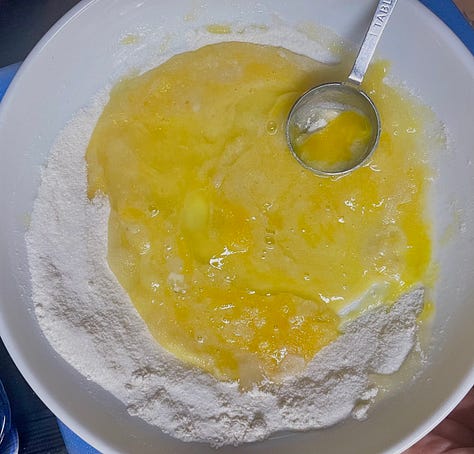
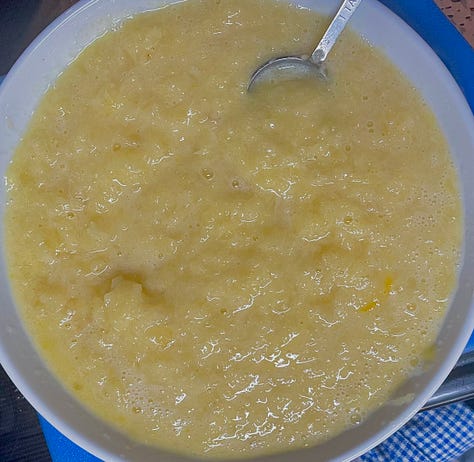

Forty-five minutes seemed like a long time, and I just knew the topping would be burned, but it looks “great”, by which I mean almost exactly the same as when it went into the oven. I’m really surprised at the lack of transformation. I wasn’t sure what role toasting ahead of baking would play as opposed to just tossing bread with melted butter, but I think it probably keeps it from soaking up too much liquid before it bakes. (It might not matter much if you use a sturdy bread, but with Wonderbread, I suspect it’s critical.)
I can’t believe it, but it didn’t stick at all. It’s an odd, slightly alarming texture, though, sort of like a super soft Play-Doh? I’ve zoomed in here so you can see it. It’s something like a “custard”, but with more body from all that pineapple fiber. I’m shocked to report that this absorbent and yellow and porous dish more or less comes out in a square.
Let’s try it!
You know, it’s “not bad!” It is a bit flat, but 1/8 tsp of salt would fix that. I still think it needs something else — maybe a little coconut in the filling, or some cinnamon, depending on the season. I served it with Cocowhip and a sprinkling of cinnamon as shown up top, and that really gave it a little punch. Honestly, given my roots I kind of wished for a little cheddar. (Sorry. )
As for what role this dish is supposed to play in a meal, I still have no idea. I can’t really say whether it’s solid or liquid, or whether it’s supposed to be served hot or cold. I don’t know whether it’s for summer or winter. It’s sort of too sweet for a side and not sweet enough for dessert. I tried it hot for dessert and cold for breakfast, both times with a sort of perplexed success. (The only thing I can say for sure? It’s definitely not a hotdish.) Like the state of “Florida” itself, it defies categorization. Is it Gulf Coast or East Coast? Mainland or island? Breakfast or dinner?
It brings to mind Florida’s boa constrictor problem. Both the pineapple and the boa are from somewhere else, imported to make someone a buck and then running amok, and yet, they seem perfectly at home there, gleaming in the sun.
“Life finds a way,” as the saying goes. You might as well eat it.
Zen and the Science of Candy Corn is a reader-supported publication that brings me great joy. You can literally give me your 2 cents with the tip jar button below!
But if you decided to subscribe, free or paid? That would be “so cool”.
And please feel free to share this post with any gratuitous quotation mark-loving psychopaths you know.





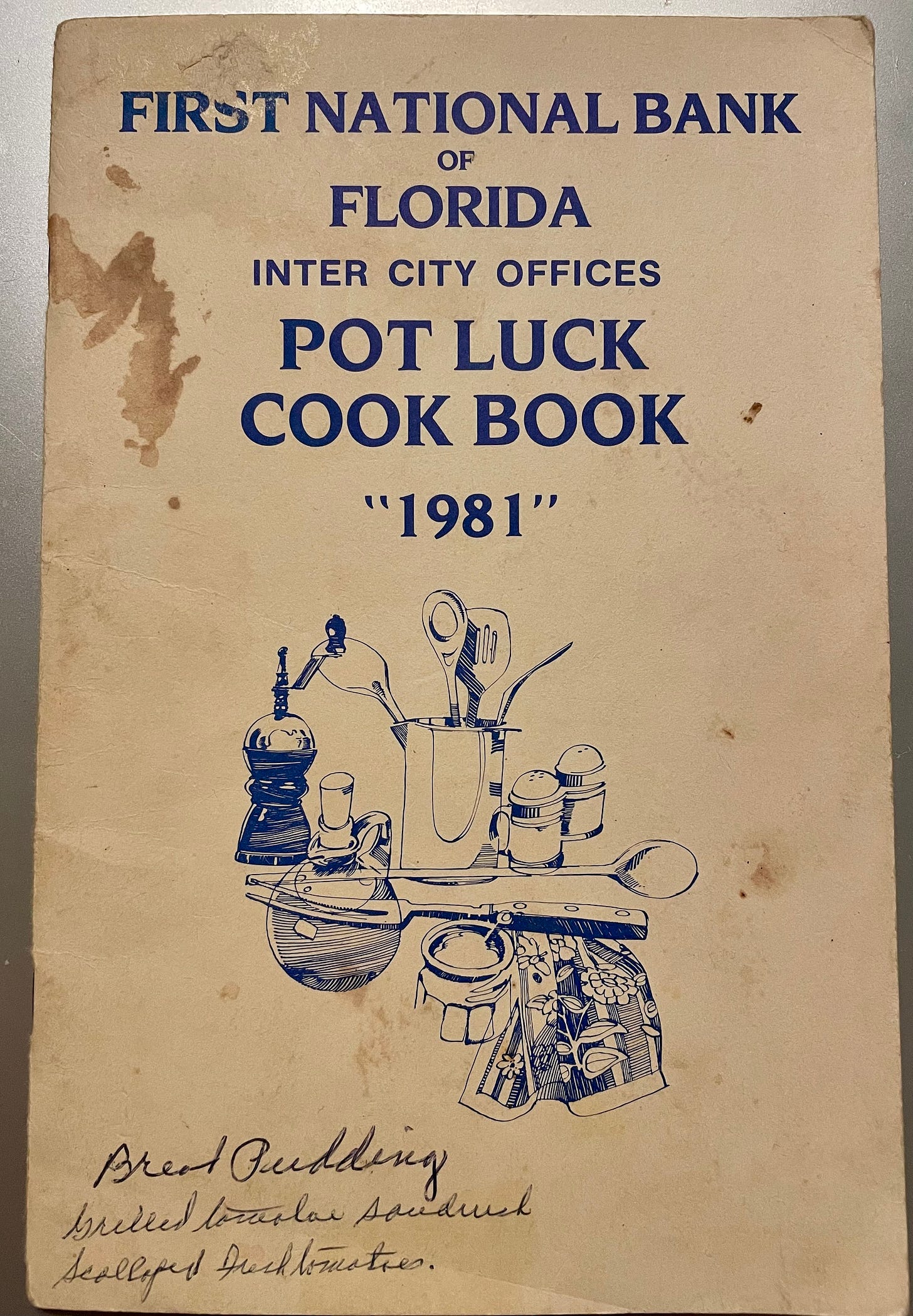
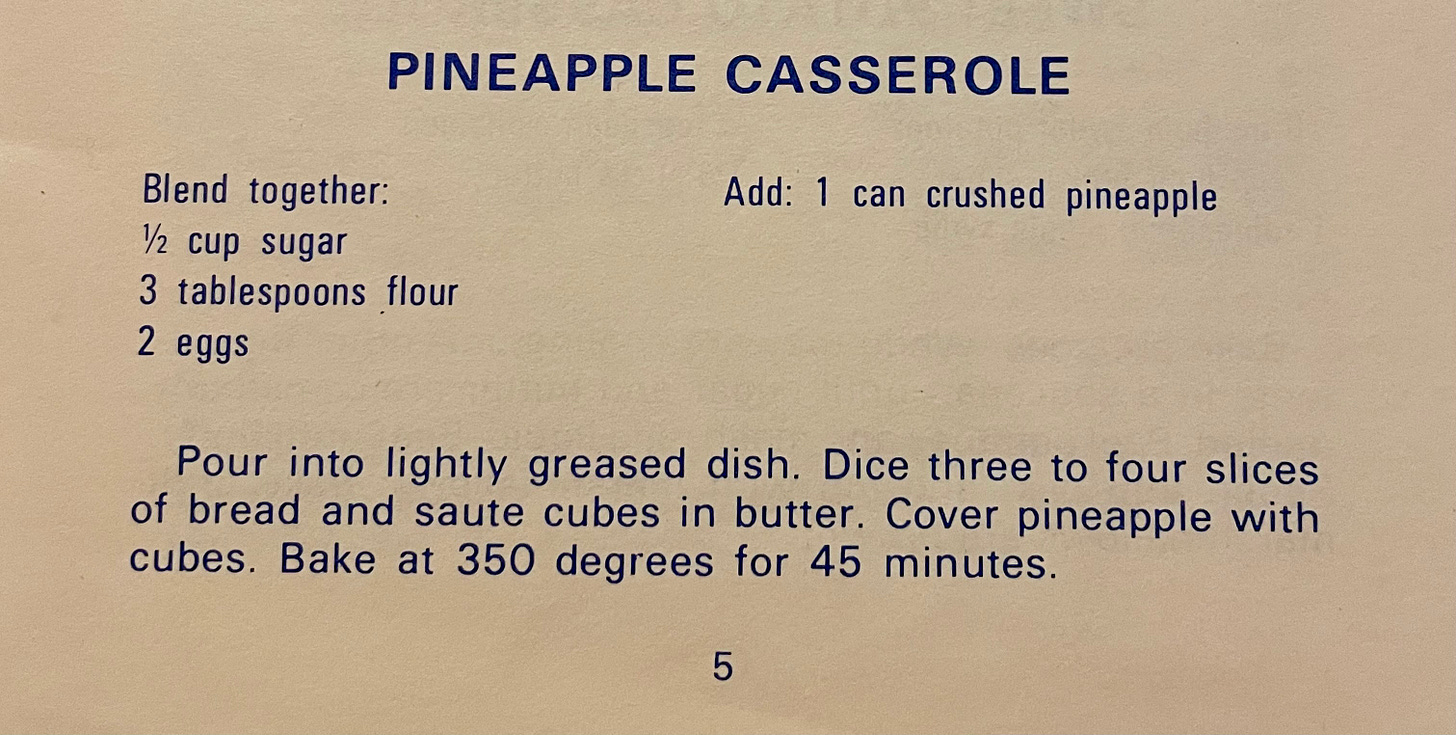


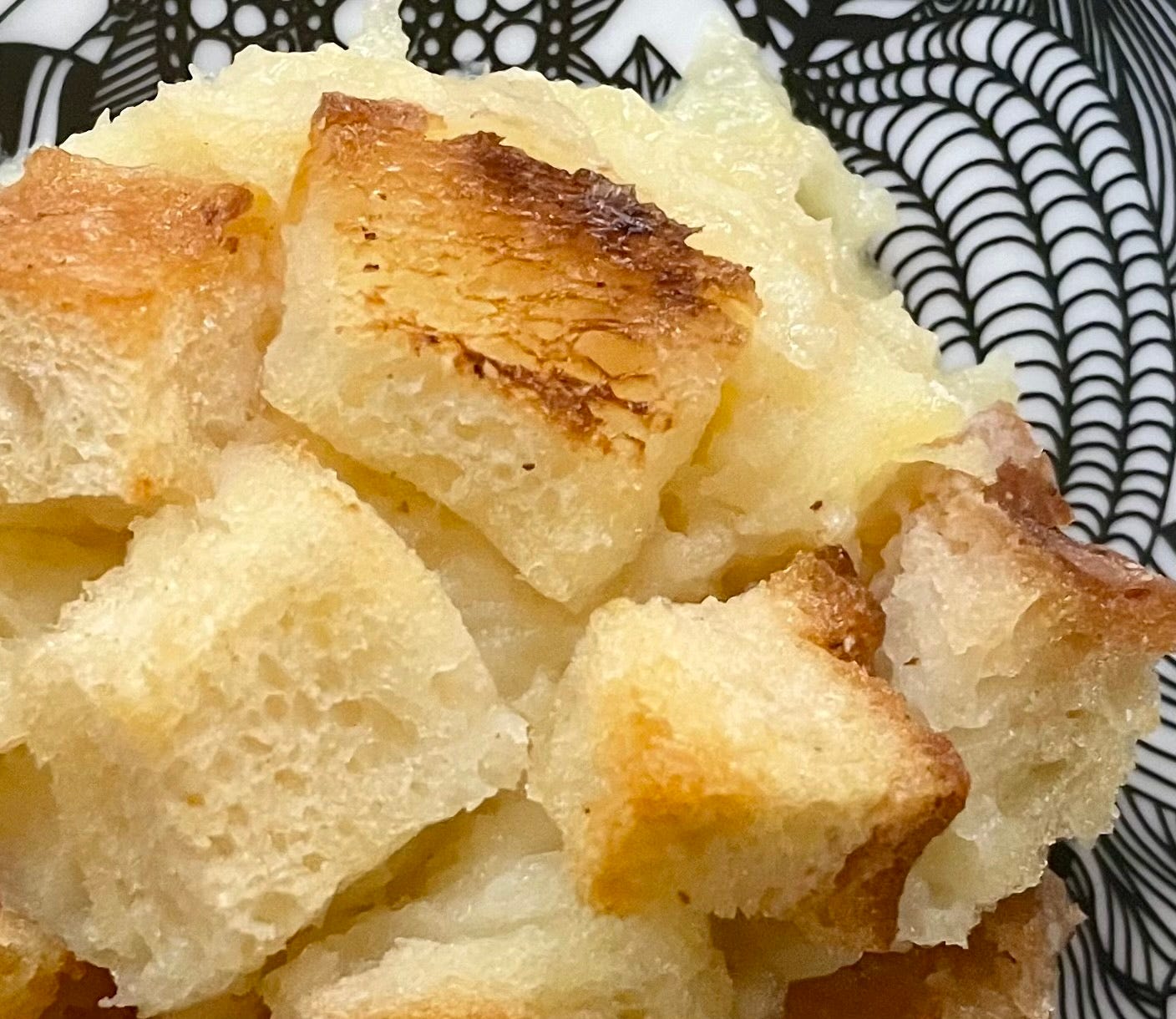
So it’s like cursed pineapple stuffing?